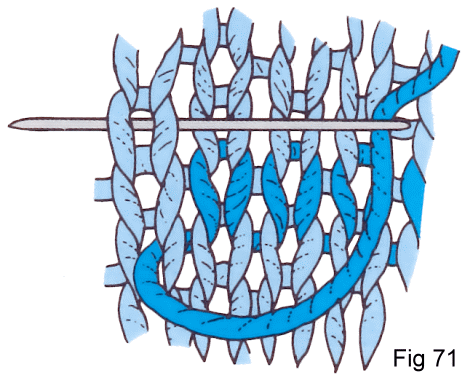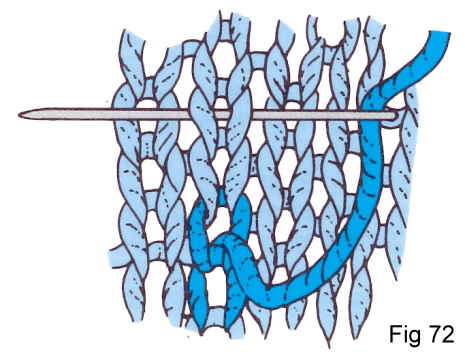Joining yarns & working with colour
Joining in a new ball of yarn
You will often need to join a new ball of yarn when the old one runs out. It is best to join it at the beginning of a row. If the yarn has to be joined in the middle of a row, pick up the new yarn and continue knitting. After you have knitted a few more rows, darn in the ends of the old and new yarns neatly at the back of the work.
Stranding colours
Use this method for fairisle patterns (i.e. patterns where two or more colours are used on the same row). Hold the colour not in use in the left hand and carry it loosely across the wrong side of the work. To work the second colour exchange the position of the two yarns and continue in the usual way, making sure the yarn not in use is not pulled tightly when changing the colours over (Fig.70).
To avoid long ‘floats’ where 6 or more stitches are worked in one colour, twist yarns together every 3rd or 4th stitch by laying the colour not in use across the colour being used before working the next stitch.

Weaving
Yarns are twisted together every alternate stitch as follows: Hold the second colour in the left hand, insert needle into next stitch, lift yarn in left hand over the right hand needle and bring the yarn in the right hand over ready to work the next stitch. Before pulling the loop through, take the left hand yarn back again and complete the stitch in the usual way. It is possible to use this method for fairisle patterns as it gives a neat appearance at the back of the work, but as it distorts the stitches and alters the tension it is not recommended unless a pattern specifically calls for it.
Colour blocks (motif knitting)
This method is used where there are large areas to be worked in one colour. In this case it is better to use a separate ball of yarn for each section. The different colour yarns must be twisted over each other, to avoid forming a hole. When the colour change is in a vertical line, cross the yarns on both knit and purl rows. When the colour change is on a slanting line the yarn needs to be crossed only on alternate rows.
Swiss Darning or Duplicate Stitch
Swiss darning is a form of embroidery on knitting which covers the knitted stitches completely, so that the finished embroidery looks as if it had been knitted in. It is a useful and versatile technique.
Working Swiss darning horizontally:
Work from right to left. Darn in the yarn invisibly at the back.
- Bring the needle out in the centre of a stitch and take it up and round the head of the stitch (under the stitch above).
- Take the needle back through the centre of the original stitch and out through the centre of the stitch on the left (Fig.71).

2. Take the needle back through the centre of the original stitch, then up through the centre of the stitch above (Fig.72).

Working Swiss darning vertically:
Work from the bottom to the top. 1. Bring the needle out in the centre of the stitch and take it up and round the head of the stitch (under the stitch above).
All content provided by TB Ramsden & Co.